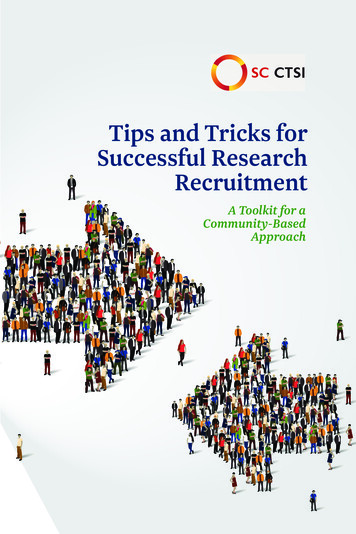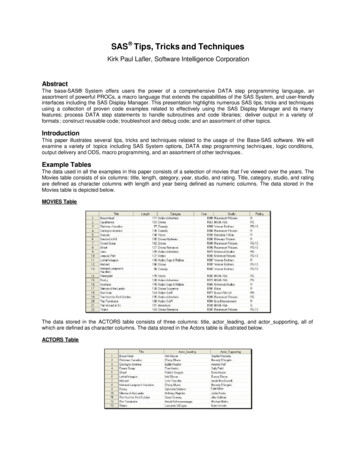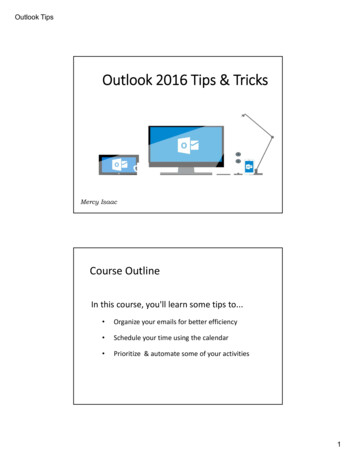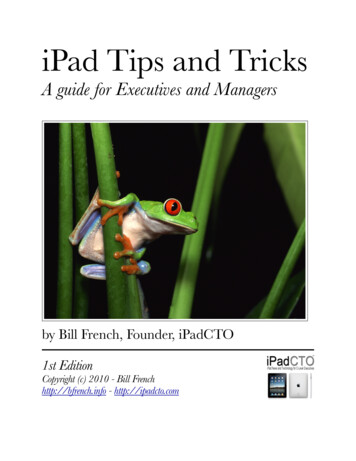
Transcription
Tips and Tricks forSuccessful ResearchRecruitmentA Toolkit for aCommunity-BasedApproach
Tips and Tricks for SuccessfulResearch RecruitmentA Toolkit for aCommunity-Based ApproachSuggested citation:Kubicek, K. and Robles, M. (2016, November 11). Resourcefor Integrating Community Voices into a Research Study:Community Advisory Board Toolkit. Southern California Clinicaland Translational Science Institute grant UL1TR001855.2Tips and Tricks for Successful Research Recruitment
ContentsIntroduction.4Preparing for Success.5Setting Goals.5Walking in Their Shoes.5Hearing from Your Participants .7Study Staff Selection and Training.8The Role of Community Partners in Recruitment.9Compensation.9Compensating the Individual.9Compensating Community Partners.9Communicating about Your Study.10Communicating to Potential Participants. 10Communicating to a Potential Community Partner. 10Digital Platforms- Social Media and Mobile Technologies.12Large Clinical Trials.14Addressing Recruitment Challenges.18Confusion About the Study.18Lack of Awareness.18Lack of Access.18Personal Objections, Fear, Distrust, or Suspicions.19Keys to Retention .19Maintain Communication .20Listen.20Be Convenient .20Maintain a Positive Attitude.21Know the Protocol.21Appendix A: Recruitment Flyer Example 1.22Appendix B: Recruitment Flyer Example 2.23Appendix C: Recruitment Flyer Example 3.24Appendix D: Creative Brief .25Appendix E: Study Summary Example 1.26Appendix F: Study Summary Example 2.27Appendix G: Study Summary Example 3.28Appendix H: Study Summary Example 4.293Tips and Tricks for Successful Research Recruitment
IntroductionDespite the investment in eradicating racial and ethnic health care disparities, enormousinequalities still exist in the United States across multiple domains, including access to careand use of services, disease prevention, chronic diseases, health status and quality of care.Whites continue to represent a disproportionate amount of research participants, as comparedto any other ethnicity.1 A 2015 analysis of 2,579 clinical trials found that 19% of trials were eitherterminated for failed accrual or completed with less than 85% expected enrollment.2 This hasmultiple implications: 1) researchers have difficulty answering questions in a meaningful waydue to the loss of statistical power, 2) there are missed opportunities for individuals to benefitfrom new interventions and medications, and 3) time, funds and other resources are wasted.4Whether you are conducting a traditional clinical trial or a trial in the community, there arecommon strategies you should consider when recruiting participants for research. This toolkitintroduces ideas on how to prepare early in the research process in order to increase theprobability of meeting your participant recruitment goals. Subsequently, it will provide specificrecommendations for large clinical trials, and the use of social media as well and communitybased research. It will also address recruitment challenges and keys to high retention.The recruitment toolkit highlights effective strategies for investigators and others to work indiverse populations. Developed by the Southern California Clinical and Translational ScienceInstitute (SC CTSI), the Clinical and Translational Science Awards (CTSA) hub housed at theUniversity of Southern California, and Children’s Hospital Los Angeles, this toolkit aims todevelop greater capacity and success in research participant recruitment, particularly in therecruitment of underrepresented populations such as ethnic minorities.About the Clinical and Translational Science AwardsThe CTSA were initiated in 2006 by the National Center for Advancing Translational Science(NCATS) branch of the National Institutes of Health. The more than 60 CTSAs around the U.S.are charged with catalyzing academic health centers (AHC) to create a supportive and efficientinfrastructure to accelerate the translation of promising clinical practices and innovations intocommunity settings. An important part of this infrastructure is the integration of communityorganizations, clinics and others into the process in order to ensure that the research conductedat these AHCs is meaningful to the populations for whom they are intended. CTSAs are requiredto have a structure, which can solicit and integrate community input into the research process.To do this successfully, research institutions must collaborate with community organizations toidentify and understand public health needs.4Tips and Tricks for Successful Research Recruitment
Preparing for SuccessThroughout the toolkit, we use the word‘participant’ to refer to those who choose topartake in research. We believe that referringto research volunteers as participants insteadof subjects is the first step for researchers andtheir team to approach the research recruitmentprocess differently, using a more communityfriendly approach. Viewing individuals as active,willing volunteers and contributors to yourresearch instead of passive subjects can helpguide your recruitment and retention approachthrough the entire research.Setting GoalsAs you consider the feasibility of your study,the participant recruitment protocol should beforefront part of the planning from the start. Is your participant recruitment goal realisticfor the population and the region in whichyou are conducting your study? Where you recruit. How you communicate about your study. Is your study timeline realistic for thenumber of participants you plan to recruit? How you approach individuals. How you compensate your participants. Are you allocating time and money towardsbetter understanding and developingthe necessary partnerships to gain thetrust of that population before you beginrecruitment? (If you do not already haveexperience with or access to the particularpopulation you are trying to reach).5There is nothing worse than assuming that youknow everything about a certain population.Even if you have worked with that populationin the past, you may find that over time,trends and values have changed. For example,we have colleagues who have worked withadolescent and young adult men who have sexwith men (or gay/bisexual youth) for more thanfifteen years. Although they have previouslyconducted longitudinal studies with thispopulation, when they received a new grantto conduct a multi-year study, they conductednew formative research to identify changes indemographics (e.g., where young men of colorhang out), identity (e.g., new terminology forsexual and gender terms such as genderqueer,cisgender), and barriers to care (e.g., stigma,transportation).There are many factors about the study andyour participant criteria that can affect: Is your recruitment approach tailored tothe interests and priorities of the targetpopulation? Have you developed an alternative plan forrecruitment in case your first plan does notsucceed?Walking in Their Shoes The structure of your study team.These factors will ultimately determinewhether you will reach your recruitment goal. Itis important to consider each and every one ofthese factors when planning your recruitmentprotocol and as you confront recruitmentchallenges in the midst of your study.A variety of participant and study factors canalter your recruitment strategies, thereforethese factors (see Table 1 and 2, next page)should be considered in the development ofyour recruitment protocol.Tips and Tricks for Successful Research Recruitment
Table 1: Participant Characteristics to Consider for Developing Recruitment Communicating with an adolescent, an adult, or an older adult can be vastly different,and where you recruit these individuals varies based on age. For example, social mediaand other digital recruitment methods will likely be more effective with a youngerpopulation.LanguageLanguage might seem like an obvious factor when developing a recruitment plan butthere is much more to this than simply translating from English into another language.Spanish for example, uses many different terms for the same thing depending on thecountry. Literacy level is another very important component to keep in mind whentranslating. Even when using English, care must be taken to carefully define medicalterms that the general population might not be familiar with or understand.CulturalNormsUnderstanding the cultural norms of your participants is key in developing an effectiverecruitment strategy. For instance, within the population of interest, is the decision-making done as a family, a community or individually? In a study conducting phonesurveys with adult Korean women we found they were most responsive when an adultKorean person called and less responsive when a young person called.GeographyCertain cities and towns have their own culture, popular locations, safe and unsafeareas of town and common hangouts for people of certain ages. Whether the region isurban or rural can also affect your recruitment strategy. For instance, in a rural farmingarea, recruiting during harvest season might not be effective as farmers and theirfamilies are working longer days.Gender/GenderIdentityThe ways in which you communicate effectively with women can be different from theways you communicate with men. Remember, women are from Venus and men arefrom Mars. What motivates one to participate can be different from the other. Therefore, what you highlight about the study and the images you use can draw more menor more women to your study. In addition, society is now beginning to recognize thatgender is not always a binary identity – there can be fluidity between the two primarygenders. Similarly, transgender identities are also gaining greater visibility in society.New terms that are particularly popular with youth populations, such as genderqueerand intersex, are also becoming more common. Therefore, researchers working withthese populations need to be careful not make assumptions about gender and theways in which someone self-identifies.Years Living inthe U.S.This factor is often overlooked. Designing a recruitment strategy for a foreign-bornperson who has been living in the U.S. for 20 years versus someone who just arrived5 years ago can be completely different, even if they are originally from the samecountry. Their understanding of and comfort with participating in anything official like research can be different. Their understanding of the English language will likely also vary.SocioEconomicStatusSomeone with a higher economic status most likely also has a higher level of formaleducation, which means they most likely already have an advantage to others in theirunderstanding of research and access to research studies. It probably would not takeas much effort to reach this population as it would to reach those of the working classand those in lower socio economic status. It is also probable that those of a lowersocio economic status have less flexibility in their job for time off to participate in aresearch study, which means your study would have to be more accommodating if youwant to have a diverse population (e.g., scheduling at nights or other non-traditionalhours). Likewise transportation or the lack of it can also be an issue.Legal Statusin the U.S.Those with no legal status in the U.S. are probably the most difficult group to reach.They do not want to be identified or stand out in any way for fear of being deported.The simple term, “research” gives the idea of being investigated which can be a veryscary thought. Finding other terms to explain research and the research process can behelpful. Also reinforcing the concept of anonymity or confidentiality can make peoplemore open to participating.Tips and Tricks for Successful Research Recruitment
Table 2: Study Factors to Consider for Developing Recruitment ProtocolStudy FactorsDescription/ExamplesCondition BeingStudiedAre there any stigmas associated with the condition you are studying? For example, mental health and HIV issues can be stigmatized among family members andin the general community. Therefore, people with these conditions may not be aswilling to participate for fear of others finding out.Study ParticipationRequirementsThe level of risk and type of involvement required to participate in a study is abig factor in the volunteer’s decision of whether to participate. Participating in a10-minute survey, an interview, or a focus group is viewed differently than moreinvasive procedures, such as a blood draw, taking medication, or having to see adoctor for other medical procedures. A onetime participation versus a study thatrequires multiple months or years of commitment is also very different. The latterwould require more time and effort on your part to explain the study process andbenefits before getting someone to agree to participate.Study BudgetAllocating study funds from the start to provide extra incentives such as healthservices, health education, food/refreshments can provide a more pleasantexperience for your participants, which can help with retention. Having the fundsand flexibility to do community based recruitment and data collection can helpyou reach underrepresented communities that may have time and transportationconstraints.Hearing from Your ParticipantsYou may not be able to “walk in their shoes”but there are other methods to hearing fromyour participants. You can do so in a variety ofways, depending on your timeline and budget. Convene at least one (or several) focusgroups with individuals who meet yourstudy criteria or with individuals whowork closely with your potential studyparticipants. Convene an advisory board that can helpinform your recruitment approach and otherareas of your study (see our Resourcesfor Integrating Community Voices intoa Research Study: Community AdvisoryBoard Toolkit for more information), or; Partner with a community organization whoworks closely with the population you aretrying to reach, as they can form part ofyour research team.You can take one or several of these approachesto receive feedback during any stage ofyour study (pre-grant proposal submission[formative research], pre-recruitment and7during recruitment). Ideally, you are consultingand reevaluating your recruitment strategiesduring all phases of your study, but the preproposal phase is by far the most effectivewhen trying to save time and money. Doing sowill allow you to determine whether your studyis feasible in terms of the timeline, budget andprotocol proposed. For example, our friendsworking with young men who have sex withmen (YMSM) populations had originallyproposed to recruit a cohort of Filipino youngmen using the same recruitment techniquesused for Latino and White young men. Theyfound that these strategies were not effectiveand had to work with their funder to explainthe challenges. Eventually, they received aseparate grant designed to figure out the bestapproaches for recruiting Filipino and Asianyoung men into research studies.This time and effort upfront will help you avoidsituations where you are unable to completethe study due to insufficient participationor asking your funder if you can reduce yourrecruitment participant goal.Tips and Tricks for Successful Research Recruitment
The research study goals in general (not justtheir specific role and responsibilities).Study Staff Selection andTrainingThe recruitment and consenting team play a vitalrole in the recruitment and retention success ofyour study. You could have developed a great,community-friendly flyer, script and consentform but if it is not delivered in a thoughtfulmanner, then the message will be lost. Whatwe mean by thoughtful is that careful thoughtand effort has been dedicated to selectingwho will be doing recruitment, how (i.e., tone,language) and where recruitment takes place(phone, grocery store, schools, etc ), keepingin mind your study and participant factors.Studies have shown that people will mostlikely respond favorably to someone similarto them, and this can be someone similar inage, ethnicity, gender, or life experiences.10Therefore, having a study team that reflectsyour target population may increase yourpossibilities of having success in recruitment.In our experience, this is truer for somepopulations than others, and the only way tofind out is by asking your target populationearly in your study. Many times, however, ithas been our experience, that the interpersonalskills of the study staff can be a greater factorin recruitment success. Hiring individuals whocan easily adapt to any situation, who areflexible, friendly, outgoing and professionalis very important. It is not just about hiringsomeone of the same ethnicity as thepopulation you are trying to reach, they mustpossess the interpersonal skills necessary forthis type of work.Providing formal training for your staff is veryimportant and often overlooked. With all thepressures of getting your research underwayas soon as possible, it is easy to simply haveyour staff complete the human subjectstraining online, review the protocol and learnall the recruitment materials on their own.However, in order to have the best results youwant to make sure everyone in your team is onthe same page about:8 The protocol and why it is important to follow Any and all financial implications for thepotential participant Who to turn to if they have questions.The training topics for your research team,particularly those who will have directcontact with potential research participants,should include the following: Humans subjects certification–– Review and provide examples (usingyour study) for: Ethics in research Voluntary nature of participation Beneficence (do not harm,maximize possible benefits,minimize possible harms) Privacy and confidentiality Overview of the study goals and topic Recruitment, consent and data collectionprotocol–– Include scenarios and practice for: How to approach a potentialparticipant How to address:–– A hesitant participant–– A “no” response–– A willing participant–– Questions asked by participants How to use the study’s datacollection tools Cultural Competence (see ourCultural Competence Toolkit for moreinformation)Include role-plays, modeling of successfuland unsuccessful approaches and time toreview and digest the material. Training forthe research team should be ongoing andshould include a review of the protocol andways to address any challenges phased bythe research team as they begin recruitmentand data collection. In order to identify thesechallenges, it is important that you meet withyour research team on a regular basis.Tips and Tricks for Successful Research Recruitment
The Role of Community Partners inRecruitmentThe obvious role of a community partner inresearch is identifying and recruiting potentialresearch participants. Although they cancertainly play a significant role in these tasks,there is more they can and should participatein. For instance, as mentioned earlier, asking acommunity partner to be a part of the formativework before your proposal is submitted canhelp you present a feasible study design andtimeline. A community partner can: Form part of your advisory board. Form part of the research team. Be a consultant who provides feedback on:–– Your recruitment materials–– Outreach strategies and study conduct–– Participant number goal Provide training to your research staff oncultural sensitivity and community outreachapproaches.CompensationCompensating the IndividualCompensation should be monetary and itneeds to a fair according to what is being askedof the participant; taking into account the timecommitment and risk of the study.There are other ways to thank your participantsthat may be of equal or more value to them.It is important to keep in mind the needsand conflicting priorities of your participants.Without being coercive (and in line with yourIRB standards), ensure that the compensationis clearly communicated in recruitmentmaterials and/or when potential participants areapproached by the research team. Examples ofappropriate compensation may include: Providing lunch or refreshments duringa focus group can be another form ofthanking your participants in additionto monetary compensation, whichdemonstrates value for a person’s time andcomfort. Providing a free medical examination orconsultation can be of great value forsomeone who does not have medicalinsurance or simply does not visit theirdoctor on a regular basis. Providing health education about thecondition being studied may be of greatvalue to your participants.9 Communicating the lab results from aclinical trial procedure can also be usefulto a participant. We have heard from thecommunity that they would like to knowthe results from the medical proceduresperformed during a research study, even ifit is simply the results of vitals, blood workor weight.Including additional compensations such asthese will allow for a more positive experiencefor the participant, which in the end will makeindividuals more likely to participate in futuretrials or influence others, such as friends orfamily to participate.Compensating CommunityPartnersCollaborating in research with communitybased organizations such as advocacygroups, clinics, associations, or other nonprofit organizations is a great way to knowget to know your target population better,receive feedback on your research protocoland tools, and it is an effective way to gainaccess to potential research participants. Theseorganizations have already gained the trust ofthe community, and; building on that trust isinvaluable. As a researcher, you should build arelationship with these types of organizationsas early in your career as possible. CommunityTips and Tricks for Successful Research Recruitment
partnerships should be viewed as long term,ongoing relationships (not project based). Onerelationship can lead to another and as yourresearch evolves so too will your communitypartnership and their role in your studies.See our Toolkit for Developing CommunityPartnerships for specific steps and tips onhow to begin a community partnership.As contributors to the success of yourresearch, the community organization needsto be compensated, no matter how greator small their involvement. There are manydemands on clinics and other communitybased organizations, and conducting researchis usually not a top priority. Even the mostminimal disruption in their workflow should becompensated such as asking front-desk clinicstaff to distribute research fliers to patients.Clinic staff are already tasked with coordinatingother paperwork and patient flow logistics, soadding another responsibility is not as simpleas you may think. Not having these recruitmentpartners and plan in place pre-proposal canreally alter your proposed study plan, IRBprotocol and not to mention your study budget.Communicating about Your StudyCommunicating to PotentialParticipantsYou get one opportunity to present yourresearch to potential participants, therefore,the development of recruitment material andscripts should not be taken lightly. Beforeyou develop the marketing materials for yourstudy, it is helpful to complete a creative brief(see Appendix D) to help guide you throughthe important goals and considerations foran effective recruitment tool. It is not justputting information on a flyer or cutting andpasting from your proposal to inform yourrecruitment script. The participant and studyfactors mentioned earlier really come into playhere. A single word can turn someone away.Certain colors and images (or lack thereof) candraw or discourage potential participants. Forexample, among the Latino community, usingthe term “investigacion” for research can bringabout suspicion or fear, as it sounds like aninvestigation of their residential status will beconducted. Using other terms like, “estudio”(study in English) can make a big difference.Who approaches the participant and wherehe/she is approached can also affect how yourstudy information is received. There is no perfecttemplate for this, given the variability amongstudies and the population. In Appendices A-C,however, you will find examples of successfulrecruitment flyers that can be adapted tohelp develop a first draft of your recruitment10material. The best way to develop recruitmenttools is to work alongside your target populationand/or with people that work day-to-day withthat population. You can do so by conductingfocus groups, convening an advisory board orpartnering with a community organization thatcan provide feedback and give you suggestions.Communicating to a PotentialCommunity PartnerWe encouraged you earlier to partner with acommunity organization in your study and inparticular for your recruitment efforts. Howyou present your study to an organizationis also important. It is not as simple aspresenting your study in the same way that itis articulated in a research proposal, abstract ora PowerPoint developed for your colleagues.It is also important to note that engaging acommunity partner is a bit different from askinga fellow researcher to collaborate on a researchproposal. This is particularly true when you arecold calling an organization. Before reaching outto a potential community partner, consider thefollowing questions:1. How and where do you begin to talk aboutyour study?2. How do you not overwhelm them withinformation?3. How do you avoid confusing them so thatthey are not left wondering, what exactlywould be my role here?Tips and Tricks for Successful Research Recruitment
Table 3: Tips: Communicating to a Potential Community PartnerBegin with a briefintroductory email This is a simple email, that introduces who you are, your project health topicand overarching goal and asks for an opportunity to meet with him/her tolearn more about their organization, the work that they do and explore thepossibility of collaborating. Include bullet points if appropriate to describe your study.Develop a one-pagestudy summary Appendices E-H provide examples of a study summary. This tool provides anoverview of your study using simple terms, bullet points, images and color. When someone has had an opportunity to read your study summary, they aremore informed and therefore better able to understand and engage you in aconversation about your study and their potential role. It gives them time todigest the information and formulate questions for you and possibly exploreinterest within the organization before even meeting with you, which willmake for a more productive first meeting.Use layman’s termsto talk about yourstudy This is particularly important in these first outreach attempts.When and how youfollow up is alsoimportant At this point you might want to also give them the option of talking over thephone. It could be a better option for them if they are busy or
The recruitment toolkit highlights effective strategies for investigators and others to work in diverse populations. Developed by the Southern California Clinical and Translational Science Institute (SC CTSI), the Clinical and Translational Science Awards (CTSA) hub housed at the











